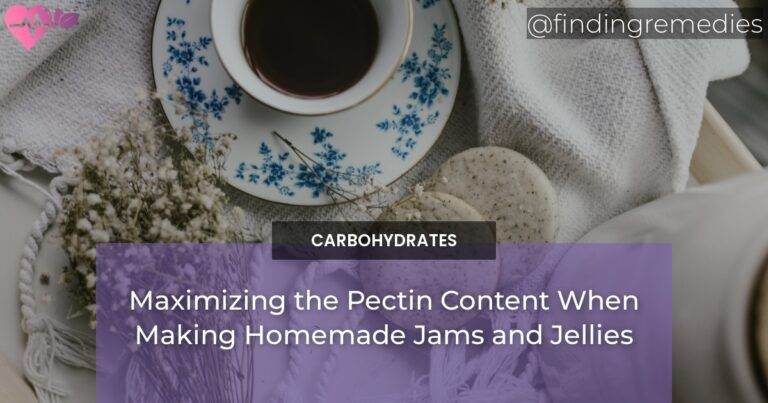When it comes to making homemade jams and jellies, maximizing pectin content is key to achieving a perfect set and deliciously spreadable results. Pectin, a naturally occurring substance found in fruits, acts as a thickening agent in jams and jellies. By selecting pectin-rich fruits, properly ripening them, using the right proportions, and understanding cooking times and temperatures, you can ensure that your homemade jams and jellies have the ideal pectin levels for a perfect consistency.
Table of Contents
Tips for Selecting Pectin-Rich Fruits
One of the first steps in maximizing the pectin content when making jams and jellies is to choose fruits with high pectin content. Look for fruits such as apples, citrus fruits, and quinces, which are naturally rich in pectin. These fruits will help your jams and jellies achieve a firm set.
It’s also important to choose ripe fruits, but not overripe. Ripe fruits have a higher pectin content, which contributes to the overall gelling process. Overripe fruits may have lower pectin levels and can result in a softer set. Additionally, consider using underripe fruits, as they tend to have higher pectin levels.
Opting for fruits with natural pectin sources can also enhance the pectin content in your homemade jams and jellies. Fruits like berries, grapes, and currants contain natural pectin sources that can contribute to a better gel formation.
Proper Ripening of Fruits for Jams/Jellies
The ripeness of the fruit plays a crucial role in the pectin content and overall quality of your jams and jellies. Understanding the importance of fruit ripeness is essential to maximize pectin levels.
Knowing the signs of fruit ripeness specifically for jam and jelly making is helpful. For example, berries should be fully colored and slightly soft, while citrus fruits should feel heavy for their size and have vibrant colored skins.
If your fruits are not fully ripe, you can ripen them at home by placing them in a paper bag at room temperature. Adding a ripe banana or apple to the bag can help expedite the ripening process. Harvesting fruits at their peak ripeness ensures maximum pectin levels and optimal flavor in your homemade jams and jellies.
Using the Right Proportions of Fruits
The ideal fruit-to-sugar ratio is crucial in achieving the perfect set for your jams and jellies. The amount of pectin in the fruit determines the amount of sugar needed for the gelling process.
Determine the ideal fruit-to-sugar ratio for your specific recipe. Adjust the ratio based on the fruit’s pectin content. Fruits with high pectin levels require less added pectin and can be paired with a lower sugar amount.
Accurate measurements are essential when making jams and jellies. Use a kitchen scale to measure the fruits and sugar precisely. Experiment with different fruit combinations to find the optimal pectin levels and flavor profiles for your homemade jams and jellies.
Adding Additional Pectin if Needed
In some cases, you may need to add additional pectin to your homemade jam or jelly recipe. Understanding when to add additional pectin is crucial for achieving the desired set and texture.
There are different forms of pectin available in the market, such as liquid pectin and powdered pectin. Follow the instructions provided with the selected pectin product to ensure proper usage.
It’s important to note that adding additional pectin can affect the texture and flavor of your jams and jellies. Excessive use of pectin can result in a rubbery texture, while insufficient pectin may lead to a runny or watery consistency.
Cook Times and Temperatures for Maximum Pectin
The cooking time and temperature significantly impact the pectin activation and gel formation in jams and jellies. It’s important to understand the relationship between these factors to maximize the pectin content.
Follow recommended cooking times and temperatures specified in your recipe. Overcooking can lead to pectin degradation and a less desirable texture. Undercooking may result in a softer set, while overcooking can make the jam or jelly too firm.
One way to determine pectin readiness is by using the gel formation test. Place a small amount of the hot jam or jelly on a chilled plate and let it cool. If it forms a gel-like consistency, it is ready. If not, continue cooking for the recommended time.
Storing Jams and Jellies
Properly storing your homemade jams and jellies is essential for preserving their quality and flavor.
Before filling your storage containers, make sure they are sterilized to prevent any contamination. Allow sufficient time for your jams and jellies to cool and set before sealing the containers.
Store your homemade jams and jellies in a cool, dark place to maintain their optimal flavor and quality. Avoid exposing them to direct sunlight or extreme temperature changes.
It’s important to understand the shelf life of your homemade jams and jellies and be aware of signs of spoilage. Discard any jars that show signs of mold, fermentation, or an off odor.
By following these tips and techniques, you can maximize the pectin content when making homemade jams and jellies, ensuring a perfect set and delicious results every time you spread them on your favorite bread or dessert.

